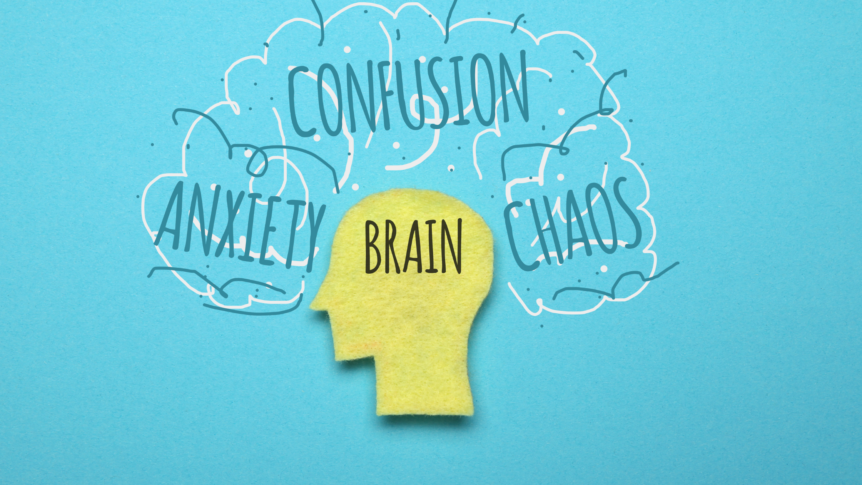Clutter is one area of our life that goes beyond the piles on the floor. My disorganized home was actually a reflection of my disorganized mind. In some ways, my thoughts were similar to the piles that surrounded me —random and scattered.
Because I wasn’t diagnosed yet, I didn’t understand that I was fighting against an opponent that I knew nothing about—one that was powerful enough to keep me under its control —mentally and emotionally.
The Process of Clearing the Clutter
During the initial COVID-19 lockdown, we had a lot of time on our hands… and a lot of excess energy. Since the physical clutter had started to overwhelm me mentally, I began to purge our home of the random things that I had been clinging to or had forgotten about.
The process of decluttering my home (rummaging throughout various rooms and closets, throwing out what no longer served me) felt symbolic.
Differentiating trash from treasure created a need to carry out the same process in other areas of my life—starting with my thought habits.
The first task to clear my mind’s clutter was learning how to rid myself of the thoughts (and thinking patterns) that were not serving me. Basically, I had to learn how to take out the mental trash.

Thinking Too Much
I think a lot. A few years ago, one friend pointed out that I had a habit of overthinking…which I had never heard of. Because I am a thinker by nature, I didn’t know that someone could think too much.
After looking into it, I recognized that was definitely a part of it…but, my overthinking went into almost obsessive, uncontrollable thoughts. Mental clutter. There were times when I would become stuck in thought cycles that felt impossible to free myself from.
Working with a therapist helped me to learn that many of my thoughts were actually rooted in distortions—with one building on the other, and me trapped beneath them. I didn’t know it, but ADHD and cognitive distortions (thinking errors) go hand in hand.
Initially, I was hesitant to accept that I had distorted thinking. However, once I got past the term, I was able to see the effects that my thinking patterns had on my life.
Thinking Errors: Distortions
Our thoughts are often based on a combination of our genetics, brain structure, physiology, past unhealed hurts, belief systems, life experiences, and our upbringing.
These factors become the filters that we use to screen and make sense of the world around us. They can also cause the errors in our thinking.

The name , thought distortions, tends to throw people off —and into denial. But, understanding when our thoughts are not rational (and are rooted in wounds, misinterpretations, or our emotions) is the only way to make the necessary corrections.
It is important to remember that thinking errors are common. Because our thoughts determine our reactions and behaviors, it is essential that we learn to think with clarity —and identify when we are not.
My hope is that the stigma and terminology don’t hold people back from being the best versions of themselves.
My “Natural” ADHD Strategies
The more I learn about my diagnosis, the more I realize how listening to our bodies can steer us towards the treatment/management paths that are best suited for us. And, that can reduce our mental clutter.
I am an advocate for observing ourselves and getting to know our behavioral patterns —and how we’ve dealt with our symptoms, especially prior to diagnosis. The strategies that I implemented (on my own) were natural responses to dealing with my symptoms.
As you read my personal strategies, consider the natural interventions that you have made in your own life.
1. Working out
Going to the gym and lifting weights allowed me to silence my thoughts. Because I was so focused on the movement and feeling the muscle , I didn’t have time to think about anything else.
Without realizing it, I was using my hyperfocus (and interest) to train my body. I was fascinated by the human body…on a cellular level.
Movement, strength, and the role the brain played in it were captivating. Being in the gym allowed me to become one with my learning process.
At the time, I had no intentions of becoming a personal trainer, I just knew that training felt like home. After my diagnosis, I learned that exercise is a useful treatment in ADHD .
2. Meditations and body scans
Learning to tune into my body taught me that it was possible for me to leave my thinking traps and emotional rollercoaster rides behind—even if it was just for the moment.
Practicing how to be present helped to relieve the frustration of living in the past and the anxiety of living in the future.
Since concentration wasn’t my strong suit, I adapted my meditations, body scans, and grounding techniques to fit me.
3. Music
Chopin’s nocturnes have had an amazingly calming and focusing effect on my mind.
Beyond those aspects, listening to his music brings me a relaxing type of joy.
It’s hard to describe, but wonderful to experience. Although my daughter makes fun of me, it works.
Something about it soothes me and gives me a reprieve from the overactive thoughts and emotions. Interestingly, there is a scientific reason that my ADHD brain is able to benefit from the music.
4. Time alone
This wasn’t about isolating, although there were times when I was mentally and emotionally overwhelmed.
This is different.
Spending quality time with myself regenerated me. Because I am also introverted, alone time recharged me.
5. Nature
Wooded trails and water are my mental and emotional safe havens. They always have been.
When I’m out, on a trail or near the water, I am more peaceful and much less scattered.
I thought it was just me…just how I am. In actuality, studies have shown that being out in nature improves focus and may calm hyperactivity . The Japanese even have a name for it—forest bathing.
6. Journaling
Sometimes, the thoughts were just too much and I needed an outlet. When I didn’t feel comfortable talking to other people, I wrote in my journal.
The benefits went far beyond the moment. Not only was I able to get my thoughts out, but (later, I was able to read them in a calm state—and recognize the distortions.
Thanks to the journaling process, I was also able to see patterns in my behavior and recognize how my emotions (and anxieties) guided my thinking—and choices. It was very eye-opening.
ADHD is a Spectrum…It’s Personal
It is important to remember that strategies are personal and will take time to uncover.
Getting to know ourselves and recognizing what brings us peace and calm is key.
Think back over your life and reflect on those things that have been your healthy, natural strategies.


